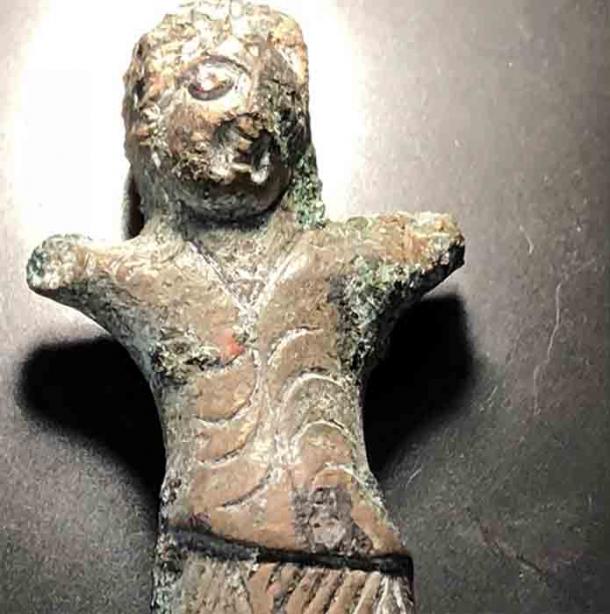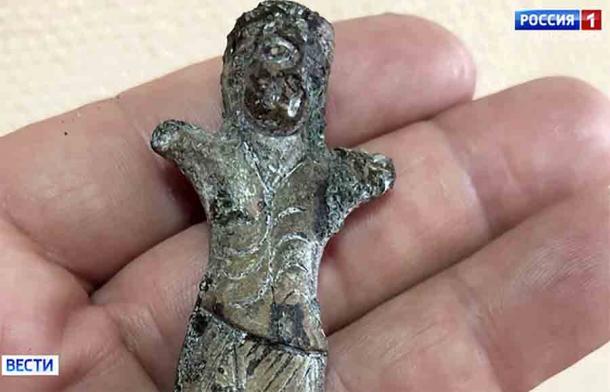During excavations along the shore of the Ob River near Novosibirsk in southwestern Siberia, a tiny, sculpted object was unearthed that has archaeologists and historians puzzled. The object was a four-inch (10-centimeter) bronze humanlike dancing figurine , which was sculpted in a way that seems to portray an individual in movement. This unusual Siberian-Indian dancing figurine has caused much excitement and for good reason.
Professor Andrey Borodovsky , an archaeologist with the Siberian branch of the Russian Academy of Sciences, told The Siberian Times that the statue portrays an Indian religious dancer, and that it was likely produced in Northern India around the year 100 BC. Since Novosibirsk and India are separated by 2,500 to 3,000 miles (4,000 to 5,000 kilometers) of quite rugged and often mountainous land, it was quite a surprise to find such a statue on Siberian soil.
This find is highly anomalous, which is why Professor Borodovsky has labeled it “one of the most significant ever made” in Siberian archaeology.

This image clearly shows the features of the upper part of the dancing figurine, head tilted to the right and downward, found in Siberia but made in northern India. ( The Siberian Times )
The Indian Dancing Figurine Found On the River Ob, Siberia
The figurine was discovered not by design, but through sheer accident. The excavations taking place in this instance were not archaeological in nature but were instead part of an ongoing bridge construction project. No one had any reason to suspect archaeological objects might be discovered along the banks of the Ob River, and it was an amazing stroke of luck that a bulldozer would unearth such a small object instead of burying it even deeper under tons of earth.
Over the course of its long journey from subtropical northern India to the frozen lands of Siberia, the small figurine was likely traded multiple times. Its final possessor may have known next to nothing about its origin, although its spiritual significance was likely understood or at least suspected.
Experts speculate that the object was left as an offering or sacrifice, by an individual seeking divine assistance while completing the treacherous trek across the hazardous Siberian river . The point where the bridge is being constructed is where the mighty Ob River is at its narrowest, and it would have been an ideal spot for an ancient trader or explorer to have attempted to make a crossing.
The figurine was found by a person (presumably a worker at the construction site) who at the moment prefers to remain anonymous. Negotiations have been ongoing, but so far the discoverer has not been willing to turn the object over to a museum for further study. He was aware of Borodovsky’s work and reputation, however, and he agreed to let Borodovsky examine the object and take pictures and make videos.

In this image you can see how small the dancing figurine is compared to a human hand. ( The Siberian Times )
Who Was the Enigmatic Indian Dancer?
The individual who served as the model for the figurine seems to have been some type of holy man or ancient priest, seeking to experience an altered state of consciousness .
“The dancer is male, since there is no clearly defined breast, and he is shown in a moment of an ecstatic or religious trance,” Borodovsky explained to Siberian Times.
The man is wearing a billowing shirt with draping over the shoulder, and a lower covering that resembles a kilt or skirt. Both arms of the statue have been broken off not far from the shoulder. But their angles of their orientation make it clear the arms were outstretched and reaching skyward. The dancing man is leaning right but the head is tilted down and to the left, consistent with the dancer making a counter-clockwise twirling movement of the type associated with certain ecstatic dances .

A wax model made from the 2,100-year-old figurine found by accident on the Ob River, Siberia. ( The Siberian Times )
‘I see the tilt of the head as something similar to what Semazen dervishes did when they danced,” Borodovsky said, referring to Sufi Muslim religious dancers called Whirling Dervishes who first appeared in the 13 th century. “They tilted heads to the left to put pressure on the carotid artery, which then led to them getting into trance while whirling.”
The small statue is made from bronze, but of a different grade than that used in modern times. The statue’s possessor allowed Borodovsky to perform a chemical analysis, and the archaeologist found that the ancient bronze was composed of 62.1 percent copper, 15,3 percent tin, 15.2 percent lead, and 7.4 percent zinc. This data points to the ancient origin of the figurine.
Taking his clues from the overall evidence Borodovsky concludes that the figurine was likely manufactured in northern India approximately 2,100 years ago. He believes it was constructed as an attachment to a larger and more elaborate object, possibly a circular ritual table with multiple dancers spinning and whirling around the table’s perimeter.

The wax model of the figurine shown from different angles. (The Siberian Times )
Did the Figurine Arrive in Siberia on the Silk Road?
The famed Silk Road trade route became prominent in Europe and Asia roughly in the last two centuries of the BC period. Developed under the auspices of China’s Han Dynasty, its main purpose at first was to connect China with the Roman Empire. The early Silk Road facilitated the exchange of valuable goods (like highly coveted Chinese silk) between the two great powers of the East and West at that time and for some centuries to come.
Inevitably, as trade intensified the Silk Road branched out to the north and south, incorporating more territory into an ever-expanding “ trade route ” network. One way to travel from Asia to Europe, and vice versa, was through the lands of southwestern Siberia , and as routes developed in this area it would have increased opportunities for objects from far-off places—like India—to be acquired by Siberian merchants and their customers.
Even if Borodovsky’s conclusions are right, and the figurine was made in India approximately 2,100 years ago, there is no way to establish for sure when it entered Siberian territory. But its date of origin is consistent with the idea that it was carried into Siberia along a Silk Road branch route and was abandoned many centuries ago at the location where it was found by accident.
It was an incredible stroke of good fortune that allowed for the recovery of this unusual and anomalous object. As of now, it represents a unique and singular discovery, which will make the mystery of its true origin and travels extremely difficult to unravel. If similar objects are eventually found elsewhere in the region, however, it might be possible to trace ancient pathways of exchange and commerce in the region more easily.
For now, the dancing figurine will remain a riddle awaiting a solution.
Top image: Two closeup images of the Indian dancing figurine found in Siberia. Source: The Siberian Times
By Nathan Falde
Related posts:
Views: 0
 RSS Feed
RSS Feed

















 May 4th, 2021
May 4th, 2021  Awake Goy
Awake Goy  Posted in
Posted in  Tags:
Tags: 
















